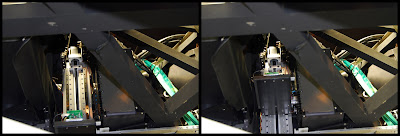Today Ant & I worked through the acceptance test procedure (ATP) for his RSS software. This involved testing all the mechanisms & making sure that everything did as it was told & that the software reported each event accordingly. We also deliberately shut down the software mid-way through various moves & procedures, to see what would happen & whether the system would know where everything was when it came back up.
Other than the temperamental waveplates, everything went extremely smoothly & the only real trouble came when we attempted to recover from the trickiest of all scenarios: the aftermath of clicking the "kill power" button while everything was moving. This is a Very big ask for any system, particularly one as complex as RSS & so it's actually pretty impressive that only the slitmask mechanism got itself really confused & couldn't be consoled by being homed. Luckily Vic was around to coax it back mechanically so it's all good!
Activating all the mechanisms provided a great photo-op, which permits an introduction to the various bits & pieces that make up this Swiss Army Knife spectrograph. The quarter & half waveplates were the only mechanisms not photographed, since they're hidden by their baffled-up housing. First up - the shutter, closed & open.
Then the grating holder - empty & with a grating in place, lowered in from the grating magazine above. The magazine holds 6 transmission gratings, 5 of them of the volume phase holographic (VPH) kind & another of the more traditional surface relief sort. The latter has a line frequency of 300 lines/mm while the VPH gratings have 900, 1300, 1800, 2300 & 3000 lines/mm.
A characteristic of VPH gratings is that their efficiency varies with input angle & so a single grating can cover a large wavelength range with good efficiency if one can change the relative angle between the collimated beam and the grating normal. The highest resolution VPH grating (3000 lines/mm) is shown below, at angles of 20, 30, 40 & 50 degrees to the beam.
The image below is of the low resolution, surface relief grating at angles of zero & 50 degrees to the beam.
The RSS camera articulates in order to preserve the Littrow configuration (in which the camera/collimator angle is twice that of the light incident on the grating) since this maximises the efficiency of the grating. Below you see the camera at articulation angles of zero & 70 degrees to the beam.
The beamsplitter needs to be inserted in order to do any kind of polarimetry. This fascinating optic was described in detail in an earlier post, but here we show it in its 2 positions, out of the beam & in the beam.
RSS employs a number of filters: 5 for order-blocking (to suppress light arising from higher order diffraction) & more than 30 interference filters that are used in Fabry-Perot mode. A filter magazine travels along the outside of the camera & once the chosen filter station's reached, the filter gets pneumatically inserted into the beam. Here we see the magazine at stations 1 & 10 of 20. Filters will need to be changed periodically based on the observing schedule.
Then there are the Fabry-Perot etalons, which are also pneumatically inserted into & removed from the beam. Only 2 of the 3 will be in the instrument at at given time - always the low resolution one in conjunction with either the medium or high resolution etalon.
The slimasks (to be used in long-slit & multi-object spectroscopy modes) are also stored within a magazine, but space constraints don't allow for a traveling magazine. Instead there is an elevator that travels up & down to fetch the desired mask & bring it to the slit plane.
The mask is then pneumatically inserted or removed. The RSS auto-guider attaches below the slit-plane & is not shown in the pair of images below.
All the while that we were playing around with RSS, Charl diligently worked away at tidying & baffling up the payload which we're hoping to lift tomorrow...













No comments:
Post a Comment